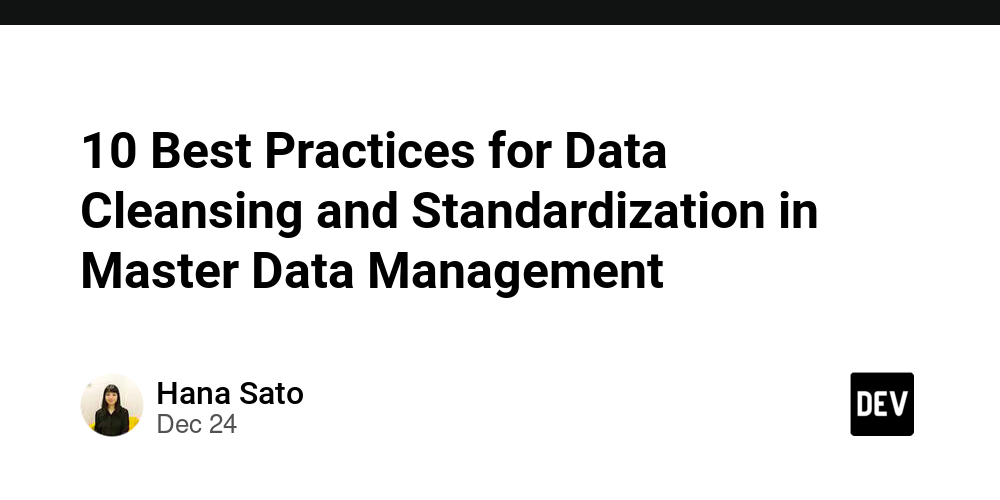In the era of data-driven decision-making, the quality of data is crucial. Master Data Management (MDM) systems such as Informatica MDMenabling organizations to establish a single source of truth for critical business information. However, the effectiveness of MDM depends heavily on strong data cleansing and standardization processes. Poor data quality can lead to inaccurate reporting, misdirected strategies and lost opportunities.
To ensure your MDM system delivers its intended benefits, here are the 10 best practices Data cleaning and standardizationtailored to real-world needs and enriched with insights into Informatica MDM best practices.
1. Understand the source and nature of data
Before implementing any data cleaning or standardization techniques, take the time to analyze your data. Understand its sources, format, inconsistencies and potential gaps. Tools included Informatica MDMLike data quality (DQ) analysis, it helps assess data completeness, accuracy, and consistency across systems.
For tips: Conduct regular data audits to stay ahead of data quality issues.
2. Well-defined data standards
Establishing enterprise-wide data standards is critical to ensuring consistency. These standards should specify acceptable formats, naming conventions, and allowed values for key data attributes. For example, standardizing date formats (for example, YYYY-MM-DD) or customer address fields can eliminate downstream errors.
Informatica MDM best practices: Automate and enforce data standards with Informatica’s rules-based standardization templates.
3. Implement a deduplication process
Duplicate records are one of the most common causes of data quality problems. They can distort analysis and lead to operational inefficiencies. Use advanced matching techniques such as fuzzy matching, phonetic algorithms, or probabilistic matching to identify and merge duplicate records.
example: A retail organization discovered 20% of duplicate customer records. They consolidated these records using Informatica MDM’s deduplication tools, saving millions of dollars in targeted marketing campaigns.
4. Validate data at entry point
The best way to maintain a clean profile is to validate it at the point of entry. Implement validation rules for required fields, format compliance, and allowed values. For example, ensuring that email addresses follow correct syntax or phone numbers follow region codes can reduce errors in advance.
Informatica Insights: Informatica MDM supports dynamic data validation workflows, ensuring real-time error detection during data ingestion.
5. Leverage data enrichment techniques
Data enrichment involves filling incomplete records with additional information, such as geolocation data, industry classifications, or demographic details. This process not only improves data quality but also enhances its usability for analysis and decision-making.
example: A financial institution enriched customer data with credit score insights to improve loan eligibility predictions.
6. Regularly monitor data quality indicators
Track key performance indicators (KPIs) related to data quality, such as accuracy, completeness and timeliness. Set benchmarks and monitor progress over time to ensure continuous improvement.
Informatica MDM best practices: Use Informatica’s built-in dashboards to visualize data quality trends and proactively identify problem areas.
7. Automated data cleaning workflow
Manual data cleaning can be tedious and error-prone. Instead, use automated tools to clean and standardize materials at scale. Informatica MDM provides advanced workflows and an AI-driven engine to automate repetitive tasks, such as identifying invalid records or reformatting materials.
Practical application: A logistics company reduced manual data processing time by 50% after using Informatica tools to automate address standardization.
8. Incorporate feedback loops
Establish a mechanism for end users to report data issues. Whether it’s a salesperson flagging incorrect customer messaging or a procurement team identifying duplicate supplier messaging, incorporating these feedback loops ensures timely corrections.
hint: Provide teams with self-service data quality tools so they can resolve minor errors themselves, reducing reliance on IT teams.
9. Invest in ongoing training
Data quality is not only about technology, but also about people. Educate teams on the importance of data quality, standards and processes. Educate them on how to effectively use tools like Informatica MDM.
Insight: Over time, organizations that invest in data literacy programs see improvements in data quality metrics of 30-40%.
10. Take a governance-first approach
Data governance is the foundation of a successful MDM program. Establish a governance framework that defines roles, responsibilities and processes for maintaining data integrity. This includes assigning data stewards to oversee data cleansing and standardization efforts.
Informatica MDM Insights: Integrate governance policies directly into Informatica’s MDM workflow to ensure compliance and consistency.
in conclusion
Data cleansing and standardization are not one-time activities—they require ongoing efforts, supported by the right tools and strategies. Leverage Informatica MDM best practicessuch as automated workflows, data analytics, and governance integration, organizations can improve their data quality initiatives and maximize the ROI of their MDM systems.
By following these best practices, your organization can ensure accurate, consistent, and trustworthy data, paving the way for smarter decisions and better business results. Clean data is not just a technical requirement, it’s a competitive advantage.
